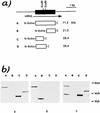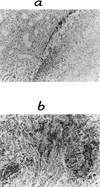A 70-kilodalton recombinant heat shock protein of Candida albicans is highly immunogenic and enhances systemic murine candidiasis
- PMID: 9573102
- PMCID: PMC108176
- DOI: 10.1128/IAI.66.5.2154-2162.1998
A 70-kilodalton recombinant heat shock protein of Candida albicans is highly immunogenic and enhances systemic murine candidiasis
Abstract
The 70-kDa recombinant Candida albicans heat shock protein (CaHsp70) and its 21-kDa C-terminal and 28-kDa N-terminal fragments (CaHsp70-Cter and CaHsp70-Nter, respectively) were studied for their immunogenicity, including proinflammatory cytokine induction in vitro and in vivo, and protection in a murine model of hematogenous candidiasis. The whole protein and its two fragments were strong inducers of both antibody (Ab; immunoglobulin G1 [IgG1] and IgG2b were the prevalent isotypes) and cell-mediated immunity (CMI) responses in mice. CaHsp70 preparations were also recognized as CMI targets by peripheral blood mononuclear cells of healthy human subjects. Inoculation of CaHsp70 preparations into immunized mice induced rapid production of interleukin-6 (IL-6) and tumor necrosis factor alpha, peaking at 2 to 5 h and declining within 24 h. CaHsp70 and CaHsp70-Cter also induced gamma interferon (IFN-gamma), IL-12, and IL-10 but not IL-4 production by CD4+ lymphocytes cocultured with splenic accessory cells from nonimmunized mice. In particular, the production of IFN-gamma was equal if not superior to that induced in the same cells by whole, heat-inactivated fungal cells or the mitogenic lectin concanavalin A. In immunized mice, however, IL-4 but not IL-12 was produced in addition to IFN-gamma upon in vitro stimulation of CD4+ cells with CaHsp70 and CaHsp70-Cter. These animals showed a decreased median survival time compared to nonimmunized mice, and their mortality was strictly associated with organ invasion by fungal hyphae. Their enhanced susceptibility was attributable to the immunization state, as it did not occur in congenitally athymic nude mice, which were unable to raise either Ab or CMI responses to CaHsp70 preparations. Together, our data demonstrate the elevated immunogenicity of CaHsp70, with which, however, no protection against but rather some enhancement of Candida infection seemed to occur in the mouse model used.
Figures






Similar articles
-
A mannoprotein constituent of Candida albicans that elicits different levels of delayed-type hypersensitivity, cytokine production, and anticandidal protection in mice.Infect Immun. 1994 Dec;62(12):5353-60. doi: 10.1128/iai.62.12.5353-5360.1994. Infect Immun. 1994. PMID: 7960114 Free PMC article.
-
Immunogenicity and protective effect of recombinant enolase of Candida albicans in a murine model of systemic candidiasis.Med Mycol. 2004 Aug;42(4):319-24. doi: 10.1080/13693780310001644653. Med Mycol. 2004. PMID: 15473356
-
Comparison of pathogenesis and host immune responses to Candida glabrata and Candida albicans in systemically infected immunocompetent mice.Infect Immun. 2001 Aug;69(8):5046-55. doi: 10.1128/IAI.69.8.5046-5055.2001. Infect Immun. 2001. PMID: 11447185 Free PMC article.
-
Initiation of T-helper cell immunity to Candida albicans by IL-12: the role of neutrophils.Chem Immunol. 1997;68:110-35. doi: 10.1159/000058688. Chem Immunol. 1997. PMID: 9329219 Review.
-
Immunity to Candida.Oral Dis. 2002;8 Suppl 2:69-75. doi: 10.1034/j.1601-0825.2002.00015.x. Oral Dis. 2002. PMID: 12164664 Review.
Cited by
-
Moonlighting proteins in medically relevant fungi.PeerJ. 2022 Sep 13;10:e14001. doi: 10.7717/peerj.14001. eCollection 2022. PeerJ. 2022. PMID: 36117533 Free PMC article. Review.
-
Effectiveness of a vaccine composed of heat-killed Candida albicans and a novel mucosal adjuvant, LT(R192G), against systemic candidiasis.Infect Immun. 1999 Feb;67(2):826-33. doi: 10.1128/IAI.67.2.826-833.1999. Infect Immun. 1999. PMID: 9916097 Free PMC article.
-
The Pathophysiology and Treatment of Candida Sepsis.Curr Infect Dis Rep. 2002 Oct;4(5):387-399. doi: 10.1007/s11908-002-0005-3. Curr Infect Dis Rep. 2002. PMID: 12228025
-
The relevance of heat shock regulation in fungal pathogens of humans.Virulence. 2010 Jul-Aug;1(4):330-2. doi: 10.4161/viru.1.4.12364. Virulence. 2010. PMID: 21178465 Free PMC article.
-
Molecular characterization of genes encoding cytosolic Hsp70s in the zygomycete fungus Rhizopus nigricans.Cell Stress Chaperones. 2003 Winter;8(4):317-28. doi: 10.1379/1466-1268(2003)008<0317:mcogec>2.0.co;2. Cell Stress Chaperones. 2003. PMID: 15115284 Free PMC article.
References
-
- Cassone A, Conti S, DeBernardis F, Polonelli L. Antibodies, killer toxins and antifungal immunoprotection: a lesson from nature? Immunol Today. 1997;18:164–169. - PubMed
Publication types
MeSH terms
Substances
LinkOut - more resources
Full Text Sources
Medical
Research Materials

